







Back to Observing Reports
April 15 to 19, 2012 at Ft. Davis
NELM 7.0 to 7.8 variable as sky glow
due to higher than normal solar activity
Seeing 3/5 to 4/5
Transparency 4/5
Telescope: 48” f/4.0 reflector and 36” f/5
Obssession (Larry Mitchell’s Telescope located at
Texas Star Party upper field)
Eyepieces:
10 and 6mm ZAO-II, 10mm Delos, 8mm TMB
Supermonocentric and 8mm prototype Delos brought by Al
Nagler
Images are from the Sloan Digital Sky
Survey (color) or the Digital Sky Survey (black and
white)
Follows are some selected assorted
interesting to very interesting objects. Enjoy!
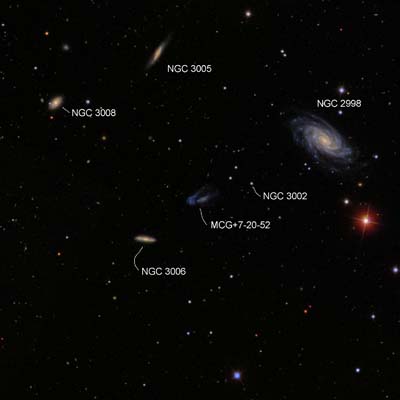
MCG+7-20-52
(was mistaken for NGC 3002 by the MCG catalog) in Ursa
Major
RA: 09 49
07.1 Dec: +44 02 52 Size:
1.1x0.5’ Mag:
17.0
48” at 488x
– The western lode was immediately picked up as a faint
2:1 elongated even surface brightness soft glow with
diffuse edges. No
central brightness. PA = 120 degrees and 0.3’ long. The western lobe
is slightly brighter than other part.
The
eastern
component is a very faint 3:1 elongated even surface
brightness glow with diffuse edges ad no central
brightening.
PA = 135 and 0.4’ long. An isosceles
triangle of 16th mag stars, which includes
NGC 3002, lies 1.5’ NW.
NGC 3002 is actually a single star.
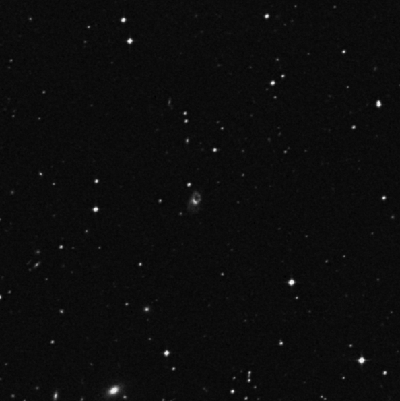 "Diamond Gem"
PGC 886902 in Hydra
"Diamond Gem"
PGC 886902 in Hydra
RA: 10 47 55 Dec: -17
12 55
Been
introduced
to this object by Jimi as the Diamond Gem as it appears
as a ring galaxy with a bright knot on the edge. I’ve researched
this object through NED and Simbad databases and found
that this is unlisted.
It appeared fairly obvious on the DSS image, so
I’m a bit surprised that it was missed.
48”
at
488 and 610x - Appears a soft glow with a bright
knot off to the SE edge.
About 0.3’ across.
A mag 15 star lies 0.2’ NNE.
Edit: Thanks to "IVM" from Cloudy Nights for
providing the catalog designation for this object.
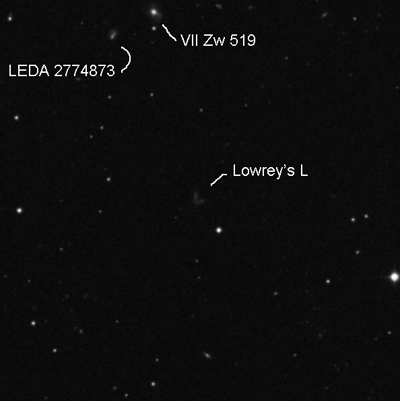 “Lowrey’s L”
in Camelopardalis
“Lowrey’s L”
in Camelopardalis
RA: 13 31
04.5 Dec:
+77 46 03
Like
the
Diamond Gem, this object is also unlisted in both
professional databases.
Photographically, it appears as two faint nearly
edge on galaxies arranged perpendicularly and
intersecting at the SE corner.
48”
at
488 and 610x – Lowrey’s L -
Very faint unresolved soft glow. 0.3’ across.
VII Zw 519
– Considerably bright, round glow with a much brighter
center with defined edges. 0.3’ across.
LEDA 2774873
– Considerably faint, slightly elongated even surface
brightness glow. PA
= 135 and 0.2’ long.
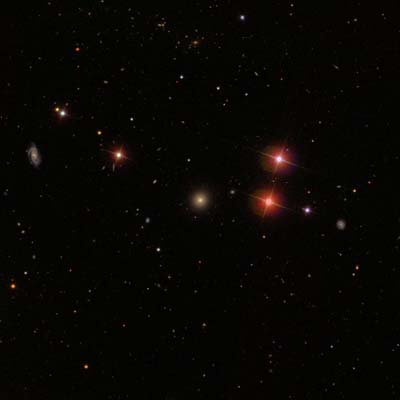 CGCG 268-26 in
Ursa Major
CGCG 268-26 in
Ursa Major
RA: 11 22
32.2 Dec: +51 31 59 Size:
0.7x0.6’ Mag:
15.4
48”
at
488x - Very diffuse halo with a stellar core. 0.3’ across. A pair of 10th
magnitude stars lies a little over 2’ west.
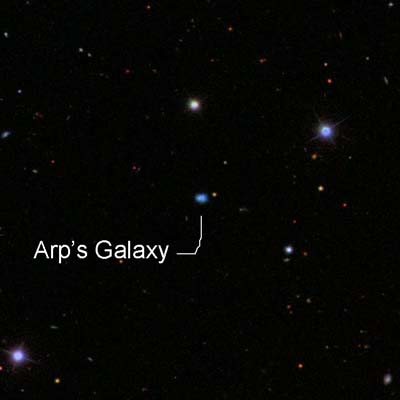
Anon 1116+51,
PGC 34658, Arp’s Galaxy in Ursa Major
RA: 11 19
34.4 Dec: +51 30 13 Size:
0.2x0.1’ Mag(NED):
16.9g
This object
was written by Dr. Halton Arp in the Astrophysical
Journal in 1965, Volume 142, page 402, titled “A Very
Small, Condensed Galaxy”.
To summarize, Dr Arp, noticed that this object
appears as a double star on plates imaged with the 200”
Hale Telescope at Mt. Palomar…upon closer look he found
that the edges were a bit fuzzy. Then he took a
spectrum of it and determined that the recessional
velocity is 1326 +/- 15 km/sec, which is consistent to
an extragalactic object…hence this object is labeled as
Arp’s Galaxy. The
original paper can be found here.
48”
at 488 and 610x
– This object was picked up as a faint very small round
glow with defined edges. 0.1’ across. I didn’t see
any elongation.
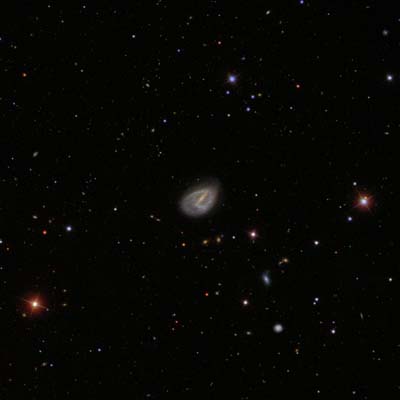 UGC 6309 in Ursa Major
UGC 6309 in Ursa Major
RA: 11 17
46.7 Dec:
+51 28 33 Size:
1.3x 0.9’ Mag:
13.7p
48”
at
488x – Nice barred spiral. The western
arm makes a complete loop back to the other end of the
bar. The
other arm wraps around half way to the other end. Stellar core
in the middle of the bar.
Very diffuse halo around the entire galaxy,
extending a little past the SE end of the bar. Bar is 0.6’
long and PA = 135.
Halo is 1.1’ long and 0.8’ wide.
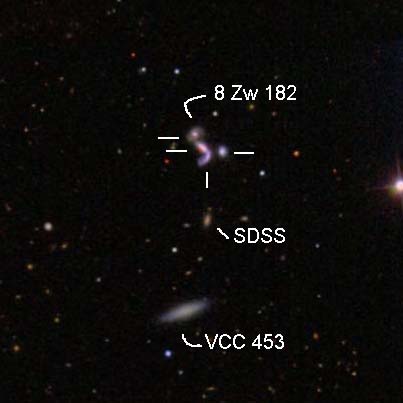 8 Zw 182 compact galaxy
group in Virgo
8 Zw 182 compact galaxy
group in Virgo
RA: 12 21
04.7 Dec: +11 37 53 Size:
32” SDSS
mag: 16.48g – 17.38g
48”
at
488 and 610x – 8 Zw 182 -
Four faint glows that are nearly equally equal in
brightness. Three
equally spaced galaxies in a line running NNE to SSW at
a length of 25”
The fourth one is at a right angle just off the
southern most galaxy at about 10” away.
SDSS
J122104.79+113655.1
– Very faint very small round glow. It was listed
as mag 18.9g in NED.
VCC 453
– fairly bright 3:1 elongated even surface brightness
glow.
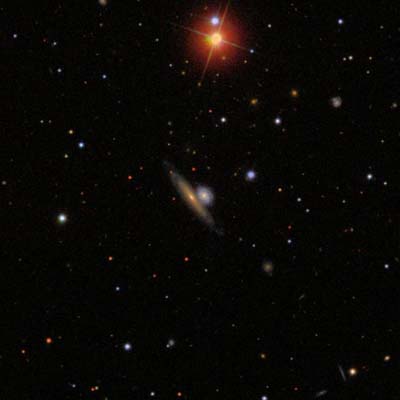 8 Zw 414 in Virgo
8 Zw 414 in Virgo
RA: 14 24
59.2 Dec:
-03 04 02 Size:
0.9x0.2’ Mag:
15.4
48”
at
488 and 610x – Two galaxies grace the field, one a
flat galaxy with a bright nearly stellar core and the
other is a high surface brightness compact small
elliptical galaxy.
Using
averted
vision, the edge on starts to grow to about 1.0’ long. PA = 45 and
1.0’ long. The
elliptical lies only 12” due west from the center of the
flat.
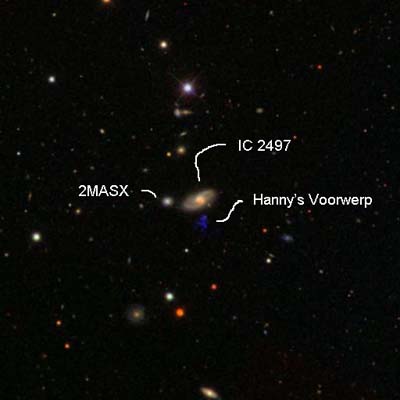
Hanny’s
Voorwerp near IC 2497 in Leo Minor
RA: 09 41
03.7 Dec: +34 43 41 SDSS mag:
18.39g NED
mag: 18.8g
This
object
was discovered by a Dutch school teacher named Hanny Van
Arkel,
very nice lady. She
is one of the key contributors of the amateur galaxy
identification site called the Galaxy Zoo. When she was
looking at the IC 2497 region, she noticed this blue
object below it… Read the rest of the story on her
website linked under her name.
Professional
astronomers
led by Dr. William Keel from University of Alabama has
determined that this object lies over 600 million light
years away. It
is a very large gaseous mass that was ejected by IC 2497
or a torn up dwarf galaxy orbiting IC 2497,
then it was lit up by a quasar in the core of the
galaxy, thus ionizing the cloud….then the quasar dimmed. This process
ionized the gaseous mass, this giving out a lot of O-III
lines, very much like an emission nebula. Here is
a synopsis of his work
on the University of Alabama website.
Since
the
primary visual wavelength are Oxygen-III lines…but it is
red shifted about 25 or so nanometers to about
523 or so nm…which explains why Jimi, Dragan and I
have found that the O-III, Ultrablock, Omega NPB, etc
did NOT work on this object. The Astronomik
CLS filter helped a little bit. Then Dr. Keel
suggested to Jimi, to give the Sloan G filter a shot. Jimi found
that the Sloan G significantly helped with this object. The bandpass
of the Sloan G (401 to 550nm) covers the O-III lines
from Hanny’s Voorwerp.
The CLS also passes a majority of the light as
540 is right at the right edge of the passband pass.
Anyhow, here is my observation with two telescopes
(different dates)
48” at 488
and 610x-
Extremely faint glow that popped in and out 50% of the
time. Used
the Sloan G filter.
It seemed tougher as we battled air glow due to
significantly higher than normal solar activity. Note: It was
far easier when I observed it last year with the 48”
scope. The
2MASX galaxy is considerably faint, round even surface
brightness glow.
36” at 457
and 571x
– Extremely faint glow that popped in and out using the
10mm Delos and 8mm prototype Delos that Al Nagler
brought.
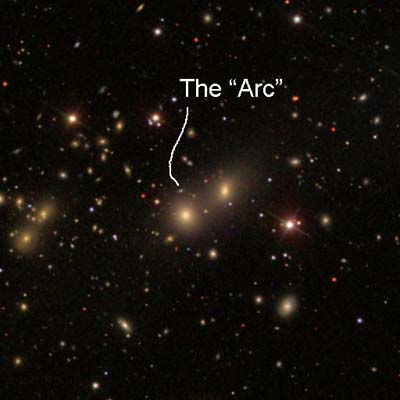
Gravitational
Arc in AGC 2152 near MCG +3-41-95 in Hercules
RA: 16 05
29.5 Dec:
+16 26 34 SDSS
mag: 20.60g NED
mag: 18.55
Larry
Mitchell
brought this arc to our attention in the 2012 TSP
Advanced Observing List titled “Anything Abell”. This is
apparently the brightest gravitational arc and probably
the only one reachable in a 30” class telescope.
A
gravitation arc is basically a galaxy or another object
much further behind a massive galaxy, which bends the
light of the background galaxy forming Einstein’s Rings.
Here
is a short piece on Wiki.
The
key
is the mag 16.4 star that lies 30” ENE from the core of
the MCG. When
the star steadies up, the arc pops in.
48”
at 488 and 610x – popped in and out 4 times. Very faint
nearly stellar object.
36”
f/5
Obsession at 457 and 571x – popped in and out 3 times,
very faint. Used
the prototype 8mm Delos and 10mm production Delos.
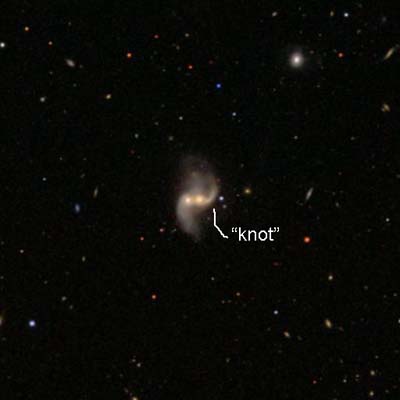 MCG+8-23-39 and UGC 7593
train wreck in Canes Venatici
MCG+8-23-39 and UGC 7593
train wreck in Canes Venatici
RA: 12 28
14.1 Dec: +44 27 12
48”
at
488 and 813x - Two bright galaxies with stellar
cores with a thin faint curved wisp starting on the west
side and turning northwards. The wisp has a
much brighter knot at the south tip.
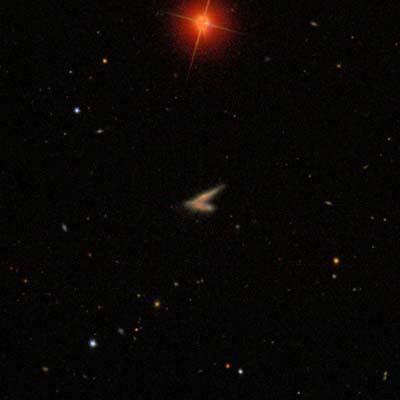
Mitchell’s
Object (MAC 1217+4634/+4635) in Canes Venatici
RA: 12 17
48.1 Dec: +46 34 56 Mags: 15.5
and 16.0
This
object
was named after a very good observer from Houston Texas
named Larry Mitchell.
Larry’s accomplishments over his astronomy career
includes creating the MAC (Mitchell Anonymous Catalog)
for Megastar,
starting the TSP Advanced Observing List and has written
several articles regarding observing and sketching
planetary nebula. He
is one of the four original owners of the 36”
Obsessions.
48”
at 488x – Only one side was seen as a very faint
thin glow. And about 0.4’ long
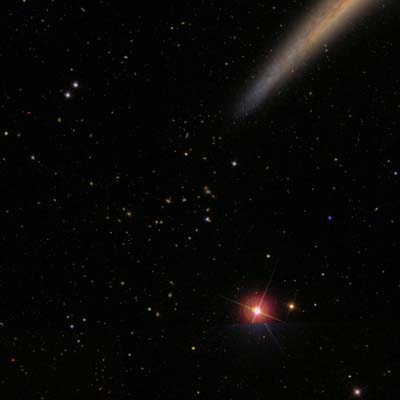 MAC cluster
near NGC 4565 in Coma Berenices
MAC cluster
near NGC 4565 in Coma Berenices
Centered
around RA 12 36 50.1
Dec: +25 50 57
48”
at
488 and 610x - Many members seen. I didn’t count
them as there were 6 other observers with us,including
Larry Mitchell, Bill Christianson, Jim Chandler, Jimi
Lowrey and several others, that I can't recall.
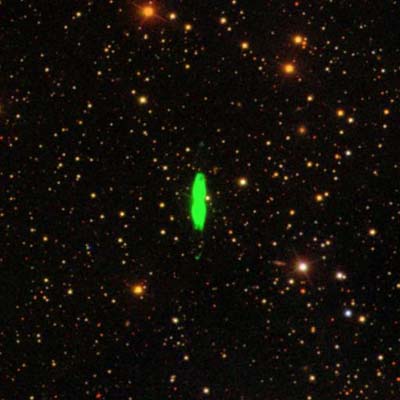
Minkowski 2-9 planetary nebula
(Minkowski’ Butterfly) in Ophiuchus
RA: 17 05 37.9 Dec:
-10 08 32 Size:
50x20” Mag:
13.2
Bi-polar planetary nebula takes on a
very different shape than your typical planetary nebula. Several
professional astronomers have determined that the
primary cause of bi-polar planetary nebulae is formed by
a binary central star.
For one of the articles, see abstract or
full paper here.
48” (488x with NPB filter) – This one pretty cool planetary, te
north side has some stellar knots. The central
star was easily seen in the center. PA = 0 degrees
and 0.6' long.
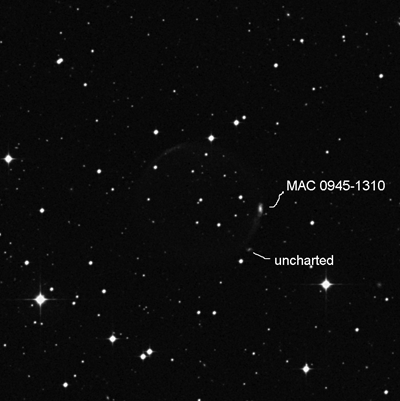 Abell 34 and two galaxies,
one is uncharted in Hydra
Abell 34 and two galaxies,
one is uncharted in Hydra
Uncharted RA:
09 45 27.3 Dec:
-13 12 01
48”
at
488 and 610x – Focused on the two galaxies. The MAC is
considerably bright 2:1 elongated glow with defined
edges and a brighter center. PA = 0 and 0.3’
long.
The
uncharted is
very faint very small round glow. 0.1’ across.
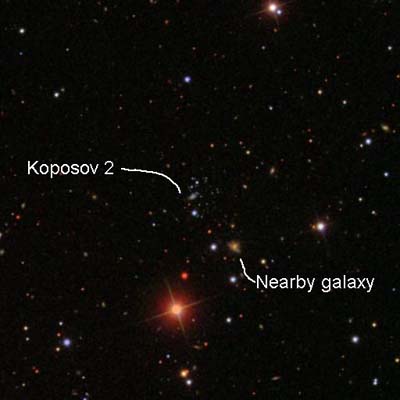 Koposov 2 globular cluster
in Gemini
Koposov 2 globular cluster
in Gemini
RA: 07 58
17.0 Dec:+26 15 18
S.
Koposov
discovered two extremely low luminosity globular
clusters in the Milky Way halo. It was
detected in the SDSS DR5 and confirmed with deeper
imaging at the Calar Alto Observatory. It was
determined that this along with Palomar 1, AM 4 and
Whiting 1 are the lowest luminosity globular clusters
orbiting the Milky Way.
The article is found here.
48”
at
488x - Very faint small round even surface
brightness glow. Popped
in and out, 75% of the time. About 0.3’ across.
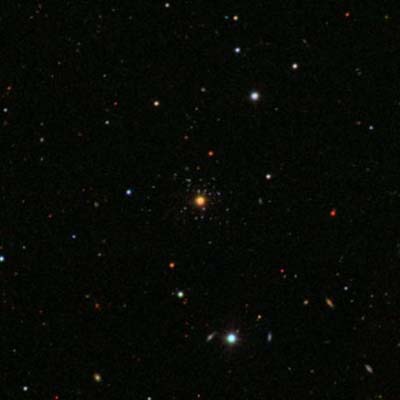 Koposov 1 globular cluster
in Virgo
Koposov 1 globular cluster
in Virgo
RA: 11 59
18.4 Dec:
+12 15 36
48”
at
488x - Some speckling was detected around a
considerably bright very small fuzzy star in the center.
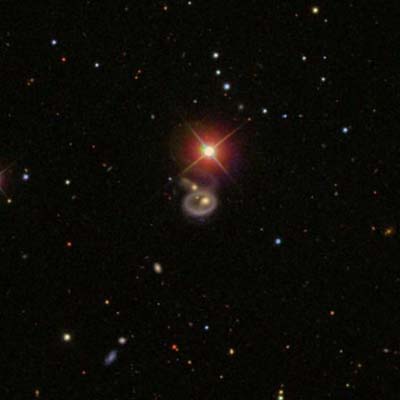 II Hz 4 (PGC 25211, CGCG
180-23) ring galaxy in Lynx
II Hz 4 (PGC 25211, CGCG
180-23) ring galaxy in Lynx
RA: 08 58
33.6 Dec:
37 05 10 Size:
0.6x0.5’ Mag:
15.7
48”
at
488 and 610x – Considerably bright fuzzy off
centered core (towards to WNW edge). The ring is a
considerably faint glow with somewhat diffuse edges. The ring is
0.5’ across.
Back to Observing Reports
All Observing Reports are copyrighted by Alvin Huey. You can print them for personal use only.
Components Aids Guides Observing Guides Reports
